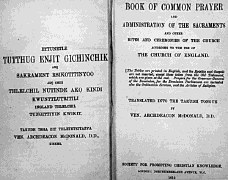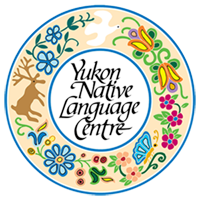Back to Gwich’in Learning Resources page
The Gwich’in Athapaskan language has also been known as Loucheux, Kutchin and Tukudh. It is spoken in northern Yukon, northeast Alaska and in the northwest corner of the Northwest Territories. The people of the Yukon Gwich’in community of Old Crow call themselves the Van Tat Gwich’in, or “People who live among the lakes,” describing the Crow Flats area. The Vuntut Gwitchin First Nation has a web site.
The Alaskan communities are Fort Yukon, Chalkyitsik, Birch Creek, Venetie and Arctic Village. Other speakers live in the Northwest Territories at Aklavik, Inuvik, Tsiigehtchic (formerly Arctic Red River) and Fort McPherson.
The Gwich’in Language has been taught in the Chief Zzeh Gittlit School in Old Crow since the early 1970’s. Gwich’in classes are attended by virtually all the students during the year.
 The first writing system for the Gwich’in language was created by Archdeacon Robert McDonald (1829-1913), a Church of England missionary who began working with the Gwich’in people in the 1860’s. He called the people and their language Tukudh or Takudh. With the help of the Gwich’in people McDonald translated the entire Bible, the Book of Common Prayer, and a hymnal. These books are still being used today by middle-aged and older people who were taught to read and write the McDonald alphabet. Most of the younger people have a difficult time reading the materials because the symbols used by McDonald are inconsistent and because the contemporary spoken language differs considerably from that recorded by McDonald. Today, young people can rely on a modern writing system that reflects the sounds more accurately and consistently. It has been used by the Yukon Native Language Centre since the mid 1970’s for use in writing the Canadian dialects of the language. Examples:
The first writing system for the Gwich’in language was created by Archdeacon Robert McDonald (1829-1913), a Church of England missionary who began working with the Gwich’in people in the 1860’s. He called the people and their language Tukudh or Takudh. With the help of the Gwich’in people McDonald translated the entire Bible, the Book of Common Prayer, and a hymnal. These books are still being used today by middle-aged and older people who were taught to read and write the McDonald alphabet. Most of the younger people have a difficult time reading the materials because the symbols used by McDonald are inconsistent and because the contemporary spoken language differs considerably from that recorded by McDonald. Today, young people can rely on a modern writing system that reflects the sounds more accurately and consistently. It has been used by the Yukon Native Language Centre since the mid 1970’s for use in writing the Canadian dialects of the language. Examples:
| man | now | gum | grass | |
| McDonald Orthography | tinjih | choog | tzih | ttlo |
| Modern Orthography | dinjii | jùk | dzìh | tl’oo |
The first line of the Lord’s Prayer is given below in both Tukudh and modern writing.
